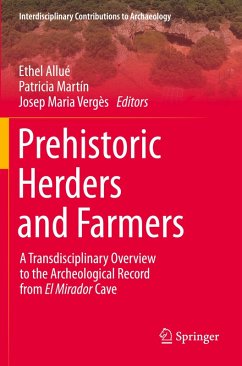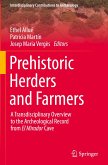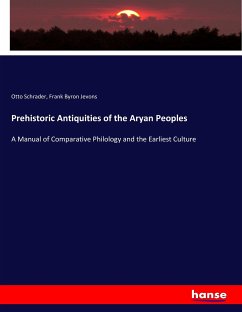Prehistoric Herders and Farmers
A Transdisciplinary Overview to the Archeological Record from El Mirador Cave
Herausgegeben:Allué, Ethel; Martín, Patricia; Vergès, Josep Maria
Prehistoric Herders and Farmers
A Transdisciplinary Overview to the Archeological Record from El Mirador Cave
Herausgegeben:Allué, Ethel; Martín, Patricia; Vergès, Josep Maria
- Broschiertes Buch
- Merkliste
- Auf die Merkliste
- Bewerten Bewerten
- Teilen
- Produkt teilen
- Produkterinnerung
- Produkterinnerung
This book presents an interdisciplinary study of the El Mirador cave located on the Atapuerca karstic system, one of the longest Pleistocene and Holocene archaeopaleontological deposits in Iberia. This book presents the results including new unpublished and published data to discuss different aspects related to the prehistoric herders and farmers that occupied this territory.
Divided into four parts, the book covers site presentation and the paleoenvironmental reconstruction covering a chronological span between 7060 ± 40-3040 ± 40 yrs. The history of the excavation and the excavation…mehr
![Prehistoric Herders and Farmers Prehistoric Herders and Farmers]() Prehistoric Herders and Farmers74,99 €
Prehistoric Herders and Farmers74,99 €![Prehistoric Fishing in Europe and North America Prehistoric Fishing in Europe and North America]() Charles RauPrehistoric Fishing in Europe and North America26,90 €
Charles RauPrehistoric Fishing in Europe and North America26,90 €![Prehistoric Man and Beast Prehistoric Man and Beast]() H. N. HutchinsonPrehistoric Man and Beast26,90 €
H. N. HutchinsonPrehistoric Man and Beast26,90 €![Prehistoric Man and Beast Prehistoric Man and Beast]() H. N. HutchinsonPrehistoric Man and Beast26,90 €
H. N. HutchinsonPrehistoric Man and Beast26,90 €![Prehistoric man and Beast Prehistoric man and Beast]() H. N. HutchinsonPrehistoric man and Beast36,99 €
H. N. HutchinsonPrehistoric man and Beast36,99 €![Manners and monuments of prehistoric peoples Manners and monuments of prehistoric peoples]() Nancy BellManners and monuments of prehistoric peoples30,90 €
Nancy BellManners and monuments of prehistoric peoples30,90 €![Prehistoric Antiquities of the Aryan Peoples Prehistoric Antiquities of the Aryan Peoples]() Otto SchraderPrehistoric Antiquities of the Aryan Peoples34,90 €
Otto SchraderPrehistoric Antiquities of the Aryan Peoples34,90 €-
-
-
Divided into four parts, the book covers site presentation and the paleoenvironmental reconstruction covering a chronological span between 7060 ± 40-3040 ± 40 yrs. The history of the excavation and the excavation methodology is detailed in this part including new unpublished recording techniques using 3D scanning and photogrammetry and a very meticulous sampling strategy. The book presents formation processes of the deposit which are key to understanding the successive occupations of the caves regarding its use as sheepfold cave as well as human remains that are part ofdifferent funerary contexts in the cave. In the last section, the book covers material culture found in the cave including lithic tools and pottery. This interdisciplinary work is of interest to scholars in anthracology, zooarchaeology, paleoanthropology, lithic technology, and experimental archaeology.
- Produktdetails
- Interdisciplinary Contributions to Archaeology
- Verlag: Agència de Gestió d'Ajuts Universitaris i de Recerca / European Regional Development Fund / Minister
- Artikelnr. des Verlages: 978-3-031-12280-4
- 1st ed. 2022
- Seitenzahl: 416
- Erscheinungstermin: 21. Oktober 2023
- Englisch
- Abmessung: 235mm x 155mm x 23mm
- Gewicht: 628g
- ISBN-13: 9783031122804
- ISBN-10: 3031122801
- Artikelnr.: 69034942
- Interdisciplinary Contributions to Archaeology
- Verlag: Agència de Gestió d'Ajuts Universitaris i de Recerca / European Regional Development Fund / Minister
- Artikelnr. des Verlages: 978-3-031-12280-4
- 1st ed. 2022
- Seitenzahl: 416
- Erscheinungstermin: 21. Oktober 2023
- Englisch
- Abmessung: 235mm x 155mm x 23mm
- Gewicht: 628g
- ISBN-13: 9783031122804
- ISBN-10: 3031122801
- Artikelnr.: 69034942








